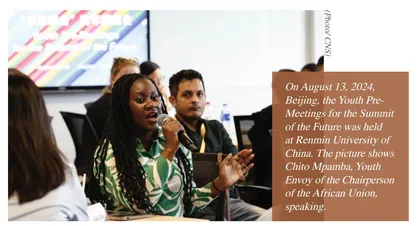China-Africa University Cooperation: Its Practical Relevance, Conceptual Trend and Innovative Mode
作者: Shan Min

Since the Forum on China-Africa Cooperation (FOCAC) was held in 2000, China and Africa have both advocated the expansion of cooperation in the field of education and human resources development, and China-Africa exchanges and cooperation on education have thus ushered in a historical process of fast development. The successive sessions of FOCAC ever since have put China-Africa education cooperation high on the agenda, where a series of initiatives and measures have been put in place, including expanding government scholarships, developing vocational education and training, launching the China-Africa Joint Research and Exchange Plan, China-Africa Joint Research Center, and the China-Africa Think Tanks 10+10 Partnership Plan as well as building the Luban Workshop. All of these have helped cultivate hundreds of thousands of professional and technical talents in Africa, and supported the enhancement of Africa’s capacity in higher education.
As universities serve as the main actors of international education cooperation, both China and Africa encourage universities to exercise greater autonomy and actively promote the establishment of high-quality cooperation mechanisms, so as to contribute to the common development of both sides. From the 20+20 Cooperation Plan for Chinese and African Institutions of Higher Education to the China-Africa Consortium of Universities Exchange Mechanism, and to the China-Africa Universities 100 Cooperation Plan, the cooperation between Chinese and African universities has continued to advance both horizontally and vertically.
Practical Relevance of China-Africa University Cooperation
In 2009, the Fourth FOCAC Ministerial Conference formulated the "Sharm El Sheikh Action Plan", where the Chinese government initiated the implementation of the 20+20 Cooperation Plan for Chinese and African Institutions of Higher Education (hereinafter referred to as the 20+20 Cooperation Plan). 20 Chinese universities and 20 African universities were selected to establish a new mode of “one-to-one” inter-university cooperation, marking the change of China-Africa education cooperation mode from government-led to university-led. Over the past ten years, the 20+20 Cooperation Plan has promoted fruitful exchanges and cooperation between the partner universities of both sides, including establishing the mechanism for mutual recognition of academic degrees, conducting joint scientific research, faculty training, academic visits, mutual visits of students and faculty members, curriculum research and development, postgraduate training and other international exchange programs.
First, China-Africa university cooperation is in line with the trend of internationalization of higher education. Internationalization is the basic logic of university development. Complete internationalization of education includes localization of international education and internationalization of local education. At present, the internationalization of Chinese higher education is in transition, therefore Chinese universities need to have a broader international vision, and shift from focusing on European and American universities to interacting with higher education institutions of other countries in the world, which will certainly include developing countries such as African countries.
With the promotion of the 20+20 Cooperation Plan, 8 pairs of partner universities in China and Africa have jointly developed majors or courses, 11 pairs of partner universities have carried out joint academic researches, joint construction of laboratories, and joint publication, and some partner universities with mature conditions have made positive attempts to extend the space of overseas education. In 2013, Yangzhou University established the China-Sudan Modern Agricultural Technology Joint Research and Demonstration Center in the University of Khartoum in Sudan. In 2018, East China Normal University and the University of Dar es Salaam in Tanzania jointly established the University of Dar es Salaam-East China Normal University workstation. The cooperation between Chinese and African universities not only promotes the development of scientific research, as well as the exchange of the management system and governance experience, but also prompts both sides to re-examine the “westward” direction and path of internationalization.
Second, China-Africa university cooperation will boost the development of the internal driving force of education in Africa. Higher education is a “necessity” rather than a “luxury” for the development of all countries. Africa is still a depression in the development of higher education in the world. In terms of scientific research, the investment in scientific research in African countries accounts for less than 1 percent of GDP, and the level of scientific research development is seriously uneven among different countries. Take scientific research publications as an example, 74 percent of Africa’s scientific output is completed by 11 percent of African countries, with South Africa and Egypt accounting for 25 percent and 22 percent respectively. In terms of the setting of majors, subject to the influence of the colonial system and the restrictions of insufficient funding, the setting of majors and personnel training in African universities have long been detached from the actual economic development of the country, with more than 70 percent of the graduates in liberal arts, resulting in a lack of skilled labor, outstanding structural problems in human resources, and a large-scale outflow of high-caliber talents.